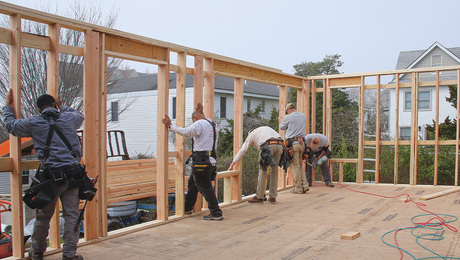Staple up Radiant, transfer plates.
Am building a 3 story house in Seattle, mild climate, and looking into staple up radiant heat. Every Heating Contractor has a different opinion and theory.
1 – Staple up pex to the subfloor, then insulate the joist bays using foil faced fiberglass leaving a 2″ “air gap” between the insulation and the subfloor. Water temp about 140 degrees, will not harm hardwood flooring.
2- Staple up pex to the subfloor, use heat transfer plates, insulate using foil reflective fiberglass bats, water temp around 110 degrees. Won’t damage hardwood floors.
3 – Hang the pex tubing about 2″ below subfloor, use a product such as ultra fin, insulate with foil faced fiberglass about 4″ below the subfloor, water temp 140 degrees, Won’t damage hard wood floors.
All three want to use a tankless water heater for potable water and heating, using a check valve so they don’t “swap spit” so to say.
What is the best method for staple up radiant flooring? Every article, manufacturer and contractor seems to have an opinion. Any ideas? Anybody ever install more then one method and have an educated answer?
Thank you
Al



















Replies
I installed 1/2" Pex with
I installed 1/2" Pex with Aluminum plates directly onto sub-fl., then ripped 8" x3/4 plywood sleepers and installed a 3/8" prefinished 9 ply hardwood floor, nailing into sleepers. It works perfectly here in the Northeast. I put in 104 deg. water. The manufacturer doesn't want the floor above 85. Ck. out Wirsbo installation guide. They show every scenario you can imagine. It's a question of where your loss is going. If it's to a lower habitable space than you don't care. If it's a garage or basement, maybe you do. Seattle much warmer than here, I think. Just make sure you gap the plates because they will grow and "click" if you don't.
I put mine on TOP of the subfloor in my new house in Hood River, OR. Didn't want to fuss w/ working under floor and having the tubing that much further from the space (i.e. the thickness of the subfloor). I made my own plywood 'warm floor' ... I also used the heat transfer plates ... ableit not continuously and I didn't attach them. This method seemed to work well. I ripped 8" wide plywood w/ 10 deg bevels to create the channels and nest/hold down the tubing. I put my engineered wood flooring down on top of that. This approach means walls that should be framed a little taller, maybe and all doorway openings framed to accomodate, but that is pretty standard stuff, too. Some framing already gives you a 3/4" leeway, so it really doesn't affect hanging drywall.
140 deg sounds a bit high for a water temp. I'd think up to 110 would be the max. especially in the mild Seattle area.
I ain't no expert ... I'm like you ... read a lot and hoped for the best. This seems to have worked out well. It's been in place, now for about 6 years, now. As with anything, you choose what is best for your situation/conditions/needs.
Thanks for the info.
Thank you for the posts.
I like this staple on top theories.
Agree
that on top of subfloor is better and easier in most cases, especially on the bottom floor. Looks into products like WarmBoard, Quik-Track, and anothers that provide channels for the tubing. Or, pour gypcrete over the tubing.
Make sure the heating loops are engineered for your home........
and climate.
Not close enough and you'll perhaps need secondary heat for the cold nites, too close and the boiler (or other) might not work to it's most optimum performance.
You can make up all your top of floor ply or osb channel spacers by rippiing, the curves with a router and template. The plates can be purchased.
The design of the loops are the key.
Best of luck.
all three are incorrect to recommend a tankless water heater in this application. It's much more expensive than a tank and not that much more efficient. If it is a very fancy and efficient unit, it's not much less than a mod/con boiler and is less efficient. Its lifespan will be much shorter than a boiler with maintenance requirements way higher than either a boiler or a tank. And running 140 from an on demand? just incredible that is still being done in 2011.
if they are talking about not separating your domestic/heating water with a heat exchanger, in my humble opinion, they are hacks. Your area has seen some very high profile failures of such systems. time to find a 4th contractor. If the words "room by room heat load calculation" do not cross his lips, look for a 5th.
You don't say how big your home in, but if it's significant sized, and you're using gas, you'll want a modulating/condensing gas boiler or high output tank water heater like the HTP Versaflo/phoenix or other.
Staple up radiant is not very efficient. Generally the water temp will have to be higher to achieve the same amount of heat than you would have from installing the radiant on the toP of the subfloor. You could use "climate panel" which is fairly expensive but nice. Or you could rip ply like was prevously mentioned and install the transfer plates in between. Staple up is a bit antiquated these days
I don't understand the concept of using a tankless water heater for both the potable water and the heating loop. Both would have to circulate through the heater, so even if you let only one through the heater at a time, doesn't the potable water entering the heater see the contamimation left there from water of the heating loop?